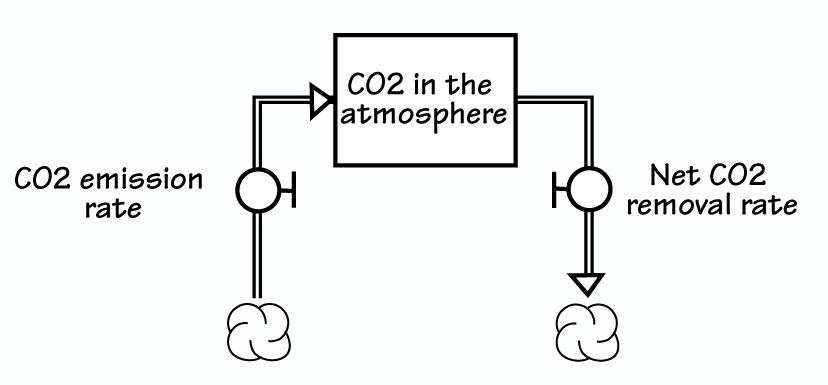Recent Bush administration statements on climate change just do not add up. The U. S. President and his advisers refer to the heat-trapping effects of greenhouse gases (GHGs) as though we can wait for overwhelming signs of trouble and then switch our course in time to avoid environmental—and human—hardship. Scientists have long known that the Earth’s climate is notoriously slow to respond to human actions. Nevertheless, the Bush administration talks as though we are driving a sports car, when we really are steering an ocean liner.
For example, in August, White House Science Adviser John Marburger briefed a Senate panel on climate change, saying, “We know we have to make very large changes if this turns out to be a problem. The consequences of human-induced global warming could be quite severe.” Yet at the same briefing, the administration stood behind its “wait and see” policy, articulated by President Bush in February: we should only “slow the growth of greenhouse gas emissions,
and—as the science justifies—stop, and then reverse that growth.” Climate change could be severe, and yet we should wait before acting. How can U. S. leadership reconcile these two seemingly contradictory statements?
Climate As a Delayed System
MIT professor John Sterman and Harvard’s Linda Booth Sweeney explain that this “wait and see” approach makes sense if you believe the world’s climate to be a nondelayed, responsive system in which a change in human activity has an immediate effect. Their recent experiments confirm that many highly competent people instinctively see climate as behaving this way. Most of their business-school student subjects thought that if humans reduced emissions of GHGs, the storehouse of those gases in the atmosphere would promptly decline and global temperature would follow.
CO2 IN THE ATMOSPHERE

Carbon dioxide (CO2) in the atmosphere, the primary heat-trapping gas, can be thought of as a stock or accumulation. The stock is now at its highest level in almost half a million years. To reduce the ecological and economic changes from producing global warming, we need to lower the level of the stock by reducing the inflow (CO2 emission rate) to less than the outflow (Net CO2 removal rate).
The inflow is currently about double the outflow. If we were to reduce the inflow by, say, 20 percent, it would still be greater than the outflow and the level of CO2 would continue to rise, albeit at a slower rate. No wonder the students predicted incorrectly—it is counterintuitive to think that the CO2 emission rate can go down while the level of CO2 in the atmosphere continues to go up! Nevertheless, it’s true. If the removal rate were constant, we would need to cut the inflow rate by more than 50 percent to finally begin to lower the CO2 level. The bottom line is this: If we, as the Bush administration says, “slow the growth of greenhouse gas emissions, and—as the science justifies—stop, and then reverse that growth,” it could still take many decades for levels of CO2 in the atmosphere to decline.
A Robust Plan
If we believe Mr. Marburger that the effects of climate change could be “quite severe,” we need a robust plan.
The Bush administration’s plan would work well if the climate had short delays. But the plan is not robust when managing a slow-responding system like our climate; the possibility of negative, irreversible effects from waiting are too high.
We see two important steps. 1. Teach ourselves the basic mechanics of our climate.
2. Act now to reduce GHG emissions. The best way to deal with a slow-moving system in which we know we will eventually need to make a change is to begin the change as early as possible. We need not initially focus on retooling our entire industrial base; we can begin with the significant reduction in emissions available through hybrid cars, better designed industrial motors, fuel cells, and renewable energy production. Such improvements could come at relatively low cost, improve our short-term economic vitality, and reduce energy dependence.
How can we get the process started? We suggest designing incentives and rewards that would unleash people’s tremendous capacity for innovation. A similar outpouring of new ideas came as a result of the ban on CFCs to prevent additional damage to the ozone layer. Let’s introduce similar mechanisms into our market system to encourage technological and behavioral changes for reducing GHG emissions.
Prudence leads us to act now to educate ourselves about the dynamics of the climate system and to address the source of the problem with practical measures. These actions will not be easy—technologically, culturally, or politically. But they are certainly easier than navigating a barge while pretending it will handle like a Ferrari.
SYSTEMS THINKING WORKOUT
Take the Challenge!
To encourage readers to send in responses to our latest “Systems Thinking Workout” challenges, we’re offering a special incentive—if we publish your diagram and commentary, we’ll send you a copy of our hot new video, Leading in a Complex World! You’ll find the latest scenarios, including “Debating the Digital Divide” (April issue) and “Investigating the FBI” (June/July issue) at www.pegasuscom.com/workout.html.
“Systems Thinking Workout” is designed to help you flex your systems thinking muscles. In this column, we introduce scenarios that contain interesting systemic structures. We then encourage you to read the story; identify what you see as the most relevant structures and themes; capture them graphically in causal loop diagrams, behavior over time graphs, or stock and flow diagrams; and, if you choose, send the diagrams to us with comments about why the dynamics you identified are important and where you think leverage might be for making lasting change. We’ll publish selected diagrams and comments in a subsequent issue of the newsletter. Fax your diagrams and analysis to (781) 894-7175, or e-mail them to editorial@pegasuscom.com.
